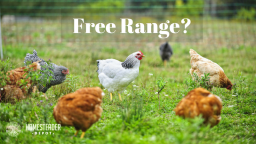With an increase in animal rights and animal cruelty awareness, the words “free range” has become a more common sight on packaging at the grocery store. It labels animal products from animals that are farmed in a way that gives them access to outdoor spaces and free access to grazing for food.
However, since there are no government regulations for the term “free range, ” the images you may have in your mind of wide open chicken yards and pastures dotted with happy cows communing with nature may not be exactly what is happening.
So, what does the term “free range” actually mean for most animals?
Free Range as defined by the U.S. Department of Agriculture (USDA) has only been applied to meat chickens. It does not actually include egg sources or other livestock like cows, turkeys or pigs.
For chickens, “free range” is defined as having access to the outdoors each day. It does not stipulate a specific amount of time, however. This lack of a more designated regulation means that chickens who spend all their lives in cramped pens with only a small hatch to the outdoors open for a few minutes daily are in the same category as chickens who roam free, only going inside at night to roost.
Essentially, the current USDA regulations mean that the chicken only needs to have a glimpse of the outdoors every day to qualify as free range. And, since the USDA regulations don’t apply to other animals or egg sources, any company can add “free range” to their packaging without risk of breaking regulations.
Look for the HFAC Certification
Fortunately, there is a way to ensure you are buying a truly “free range” product without having to visit each provider yourself. The Humane Farm Animal Care organization (HFAC) certifies farm with their own set of regulations to qualify as free range.
If a farm has received the HFAC cert, it signifies that chickens have at least two square feet per bird inside their pens and must be allowed to spend a minimum of six hours a day outdoors as weather permits.
The HFAC has even taken these principles a step further by including a “Pasture-raised” certification. To qualify for pasture-raised status, the farms are required to provide over 100 square feet PER bird. Additionally, the birds are allowed to live outdoors year-round in rotating field areas. A shelter is provided specifically to protect them from bad weather and predators, not as a way to “store” them.
Certified Organic Qualifications
Another way to ensure you are buying actual free-range products is to stick to “certified organic” products. These products are regulated by a much stricter set of regulations that includes a reasonable definition of free-range treatment.
Look at it this way. A farm claiming to have free-range eggs won’t suffer any penalties or fines if it isn’t true. However, if a farm claims to have Certified Organic eggs and are caught not adhering to those standards, they will be hit with severe penalties and fines.
Always Check the Packaging
So, now you know that even if a product is labeled “free-range” it doesn’t always mean what it should. Instead, check for the HFAC cert info or for the Certified Organic info if you want to make sure that what you are buying actually fits into the category of free range as it should.
Taking a little time to double check will help ensure you are getting the healthiest possible product for you and your family.



